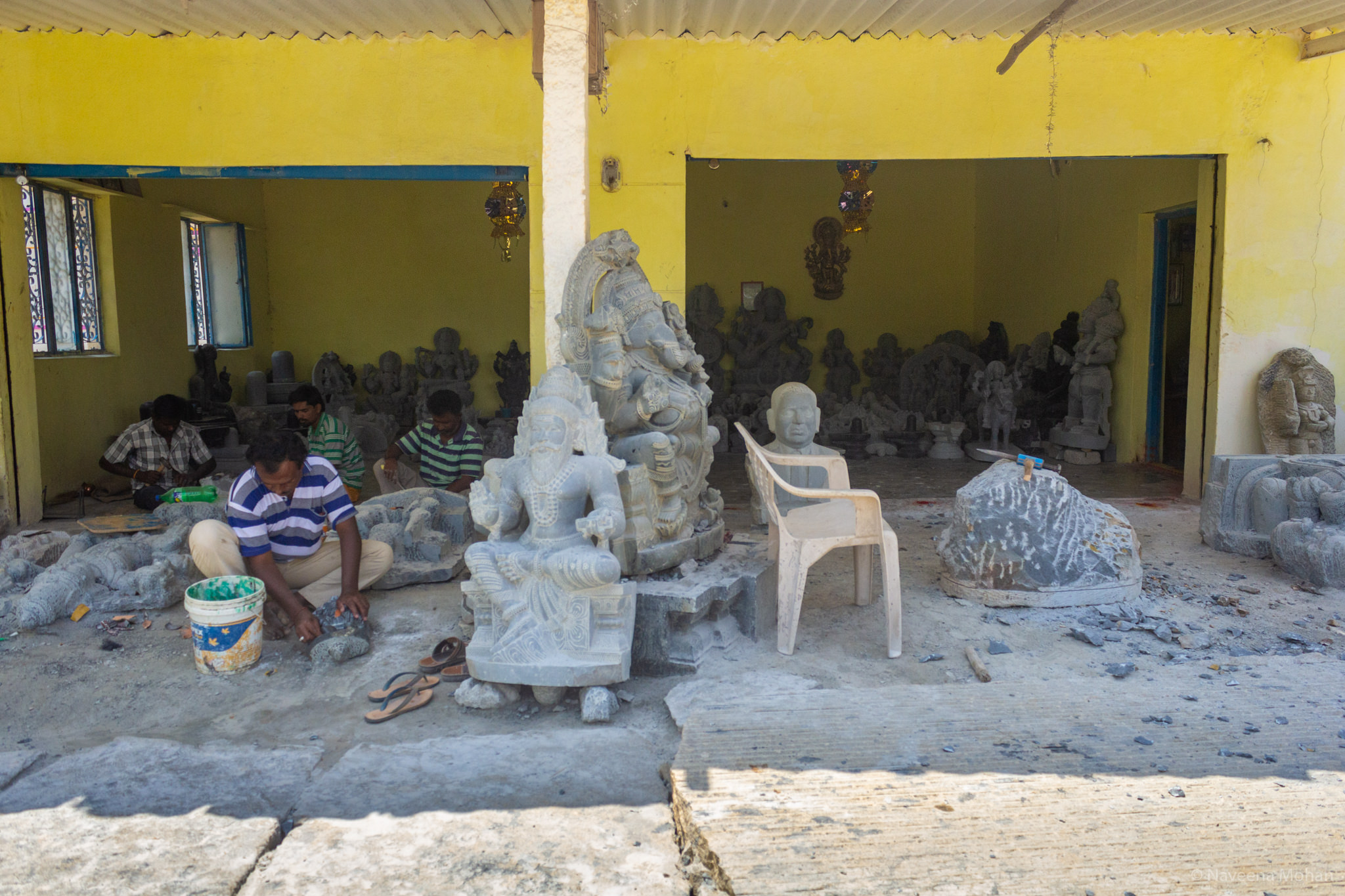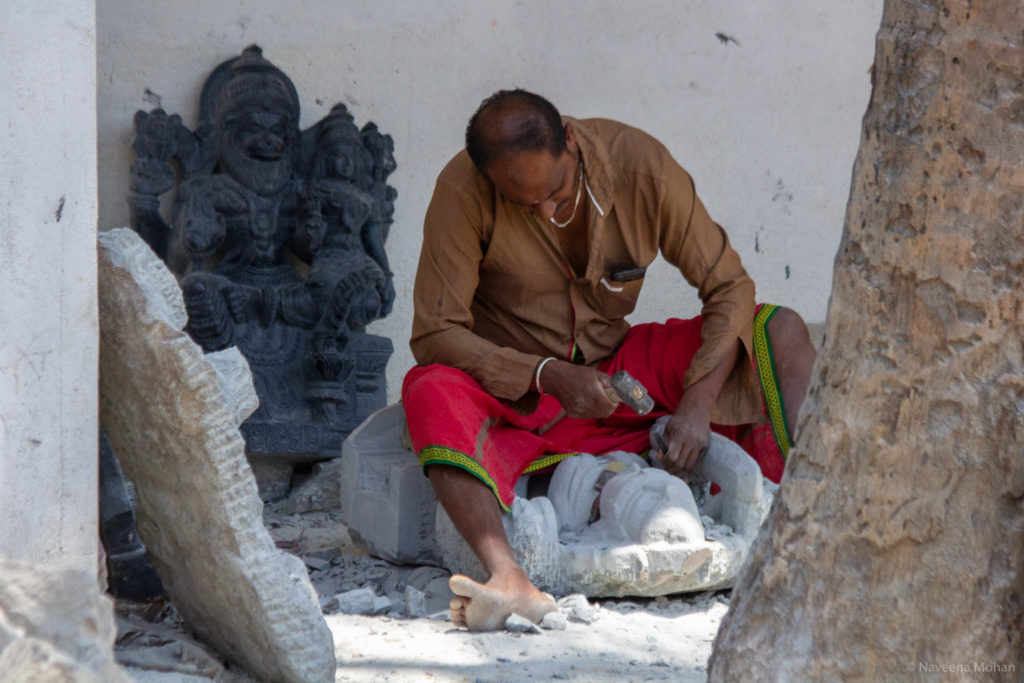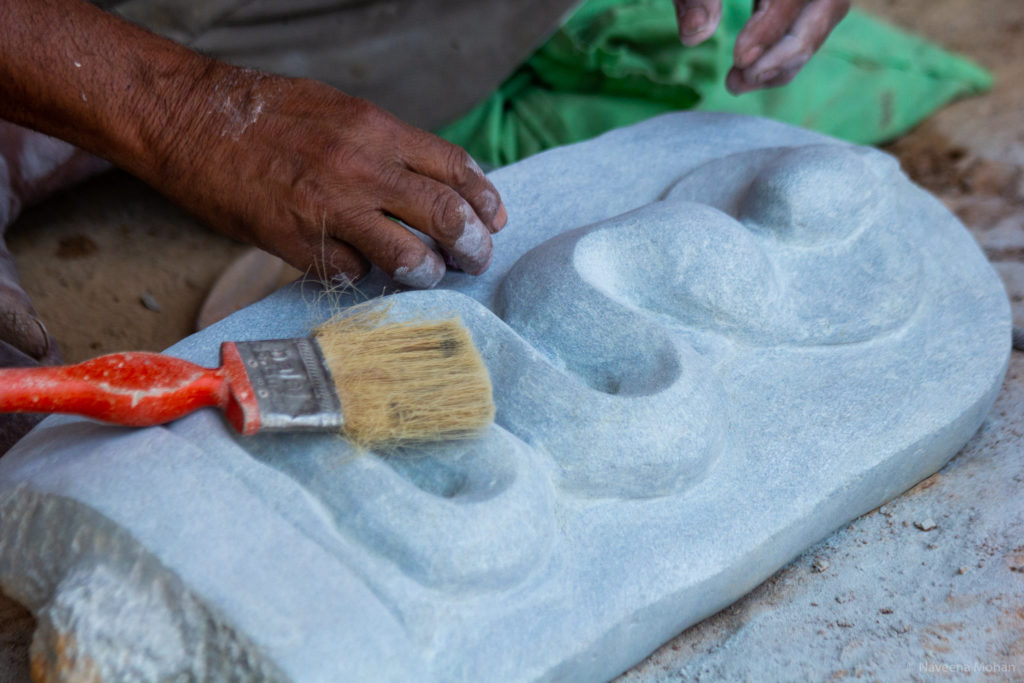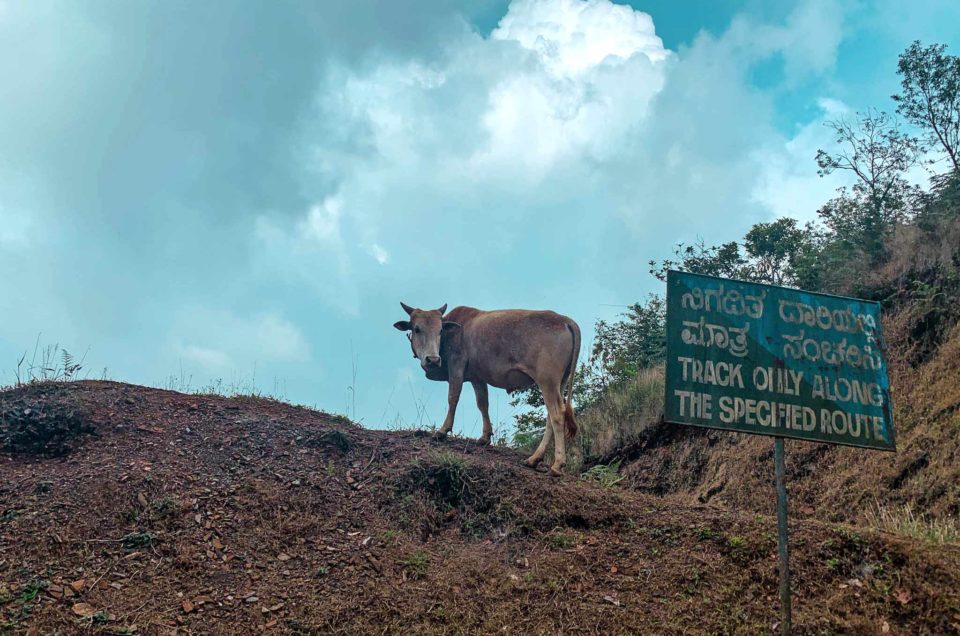Almost 2 weeks of stay in Bangalore and yet I had not ventured out and visited any new place – very unusual of me! Well, a wedding in the family soon and some hectic schedule in preparation kept me busy but the heart was pining to do or see something I haven’t done or seen before. One day’s break and the right opportunity on a weekend just before I returned to Mumbai, I couldn’t let it go waste. Knowing my predisposition to visit or watch unusual places and activities, my friends keep me posted with ideas and places that would interest me.
There is a place close to Bangalore where the stone idols are carved. The people of that entire village are engaged in this activity. They take orders to make idols for temples, bungalows, etc and that is how they earn their livelihood. You should visit this place and write about it. You will be fascinated seeing the entire street busily working on stones – were the exact words of my buddy Guna Venkatesh. When she recommends a place, one cannot give it a miss, believe me. And I was glad that I finally made it to the place, it surely is fascinating to see rocks skillfully chiselled and brought to life.

The main road to Shivarapatna
In Hinduism, God Brahma, the self-born, is considered to be the creator of this universe. Enter Shivarapatna and watch deftly working hands holding the chisel and hammer infusing life into the rocks and creating the creator and all other gods & goddesses. Shivarapatna, a place where even the creator is created! And of course, some famous personalities from the world of movies and politics can be seen in the form of life-size idols or the busts. Not even a one-horse town, this one road town if you may say so or this one lane place is a remote village of Malur Taluk in Kolar district (yes, the once-upon-a-time famous goldfields/mines – KGF is close by), Karnataka state.

Shivarapatna, the signboard announces that we have arrived at our destination
- Government school
Just less than 60 kms from Bangalore and a cool one hour drive take us to this silent road of Malur where rocks & stones in all shapes and sizes on either side of the road greet us as we curiously enter the village. A sage in deep meditation, huge Garuda Kambha (the pillar found in front of most of the temples), stone mantapas, idols of yakshas, snake carvings on stones or some gods and goddesses in stone…all make for an intriguing sight.
- Stone Pillars in the making
- Idols all the way!
Silent street and a sudden shrilly whine of a blade cutting the stone and once again a pause before a clink clink sound is heard closeby! Park the vehicle in the shade under a tree and walk towards the sound and find a pair of motionless hands with hammer and chisel and quizzical look on the face staring back at you – all from behind a cloud of dust emerging from the polished stone or by the side of a half-way-through idol of some god or goddess! Are we there to place an order for the idol or are we the curious travellers, definitely we don’t look like the college-going students there, on a project – we are summed up within minutes by the onlooker and then greeted with a smile. You want to take a look at these idols and take pictures?

The godess in the making – use of modern tools help in giving finer finishing touches
Oh, they are used to all types of visitors. Friendly, smiling and more than willing to explain the work involved in making these stone sculptures, could be the summary about the people whom we met in this land of sculptures. The major population of this place belongs to Vishwakarma or the craftsmen community and each and every house here has a workshop and definitely a decent stock of idols, all made to order. The open courtyards by the roadside double up as their godowns/showroom even as the artisans bury their head in the stone and concentrate on chiselling the finest features to the soon-to-be-ready idol of a goddess. No wonder that this place is popularly known as the ‘Karnataka’s Shilpakashi’.

Almost every house has a workshop and artisan can be seen working on the stone
- Idols – big, small and some inside the workshop
- Suclptor immersed in his job

It’s a busy day in Shivarapatna
The raw material, black stone and soft grey granite stone is primarily sourced from within the state but if required obtained from the neighbouring states, too. Right from carefully choosing the right stone, making the primary sketch, carving the rough idol up till the careful final sculpting, every step involves high levels of expertise. The polishing of the sculpture is yet another skilful job. This traditional skill of carving is passed on in the family to the next generation.

Stone, Chisel and a hammer, is all they need to carve the poetry in stone
- Precision is the key to carving perfect features
- Snake sculpture

Idols inside the workshop
Spending time watching the sculptor go about his work in full concentration and in between the short breaks, the small chat with him and a few others managing the workshop provides great details about their work & the time frame involved in carving the idols.
Me: How long does it take to make an idol?
Manager: It takes anywhere from 1 week to 6 months depending on the scale and complexity
Me: From where do you source the stone slabs?
Manager: Some we source from within the state and some from Tamil Nadu
Me: How do you go about sculpting?
Manager: First a rough sketch is made on the slab and then we start chipping off big chunks. Once we arrive at a shape, then we use different machine tools as well as by hand to give it a finishing touch.
Me: What are you currently working on?
Manager: We have an order of 6 identical idols to be made for a temple. It takes about 4 months to make.
- Master Craftsman
- Craftsman in work
- This goddess will soon adorn the temple sanctum sanctorum
- The idol in the final stages of finishing
One can spend the entire day visiting the workshops one after the other, down the lane and observe the work in progress. The idols made here not just make their way to the temples in and around the state of Karnataka or for that matter different parts of India, the idols are also shipped overseas. ‘Recently, we shipped a huge idol of Padmasambhava to Thailand’, announced an artisan with great pride. Some adorn the temples, many become a part of the apartment complex and the gleam in the eyes of the artisan is unmissable when he says that the idols carved by them are an integral part of popular landscape projects within the country as well as abroad.

Colorful sight!

Finished Idol

Vedavyasa?

Hanuman

Assorted idols
A huge stone idol of Ganapati, the charming Venugopala (Shri Krishna), Goddess Lakshmi, the colourful Hanuman idol, and many such idols can be seen all along the street and in the workshops. As I walked down the lane watching the idols and the artisans working on the stones and crafting their next idol, a simple thought crossed my mind – These idols of gods and goddesses would adorn the inner sanctum sanctorum of many a temples and most of the visitors to these temples with folded hands bow their heads and offer prayers in front of these deities. But how many minds would be curious to know from where these idols made their way into the temples or how many of us would spare few minutes to think about those hands which transformed the rough rock into those idols and sculptures that invoke the sort of devotion or awe and appreciate the skill and talent of the sculptor? Make a visit to this non-descript place called Shivarapatna and meet those people who talk to those rocks with their skill and bring the best out of them!

Skilled sculptor















Leave a reply